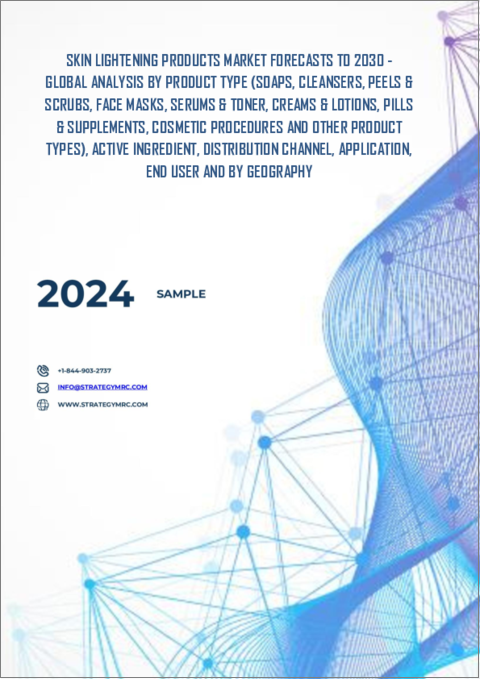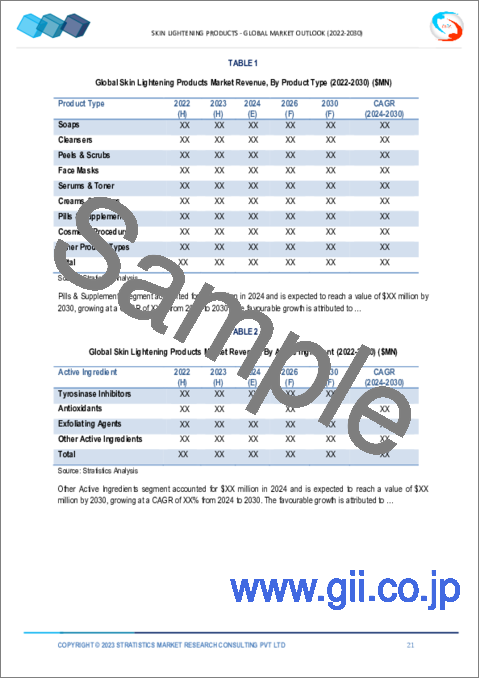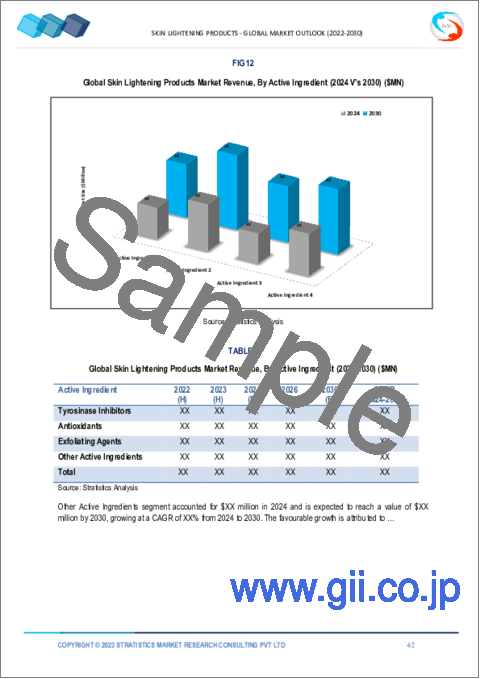|
|
市場調査レポート
商品コード
1447147
スキンライントニング製品の2030年市場予測:製品タイプ、有効成分、流通チャネル、用途、エンドユーザー、地域別の世界分析Skin Lightening Products Market Forecasts to 2030 - Global Analysis By Product Type, Active Ingredient, Distribution Channel, Application, End User and By Geography |
||||||
カスタマイズ可能
|
|||||||
| スキンライントニング製品の2030年市場予測:製品タイプ、有効成分、流通チャネル、用途、エンドユーザー、地域別の世界分析 |
|
出版日: 2024年03月03日
発行: Stratistics Market Research Consulting
ページ情報: 英文 200+ Pages
納期: 2~3営業日
|
全表示
- 概要
- 図表
- 目次
Stratistics MRCによると、スキンライントニング製品の世界市場は2023年に114億米ドルを占め、予測期間中にCAGR 7.5%で成長し、2030年には189億米ドルに達すると予想されています。
スキンライントニング製品は、メラニンの生成を抑え、肌のトーンを明るくすることを目的とした化粧品ソリューションです。これらの製品には、メラニン合成を阻害するハイドロキノン、コウジ酸、アルブチンなどの成分が含まれていることが多いです。色素沈着や濃いシミに対処するために使用する人もいるが、広く使用されることで懸念が生じる。
SkinStoreのレポートによると、アメリカ人は年間平均322.88米ドルをスキンケアに費やしています。従って、同地域の市場は当面大きな成長を遂げると思われます。
高まる美容基準
社会的圧力とメディアの影響は、消費者が理想的な肌色を実現するために製品を求めるようになり、市場の拡大に寄与しています。この動向は技術革新を促し、メーカーは先進的な処方を開発します。しかし、非現実的な理想を助長する公正基準に対する懸念も同時に高まり、社会的態度の変化につながっています。さらに、一部の消費者は現在、多様な肌色を祝福し、従来の美白化粧品の優位性に課題する、包括性を優先しています。
有害な副作用
肌荒れや損傷を含む副作用は消費者の信頼を損ない、その結果、市場の需要に悪影響を及ぼしています。健康リスクに対する意識の高まりと、ハイドロキノンのような成分に対する規制当局の監視が、製品の信頼性をさらに低下させています。消費者は現在、安全性を優先し、自然な代替品にシフトし、美容業界をより倫理的で持続可能な慣行へと舵を切っており、これが市場成長の妨げとなっています。
ナチュラル・オーガニック化粧品への需要の高まり
健康や環境への関心が高まるにつれ、消費者は化学物質の少ない製品を求めるようになっています。このシフトは、スキンケア業界におけるナチュラル・オーガニック代替品への需要の高まりを促しています。その結果、刺激の強い化学物質を含む従来の美白化粧品は、消費者がより安全で持続可能な選択肢を優先するようになり、課題に直面しています。市場は、天然成分を取り入れ、透明性を促進し、倫理的慣行を強調することで適応しています。
長期的効能の欠如
一時的な効果をもたらす製品はユーザーの幻滅を招き、市場の需要減退につながります。消費者が永続的な解決策を求める中、市場はその魅力を維持しようと苦闘しています。課題は、短期的な成果と持続的な効果のギャップに対処することにあります。業界が成功するためには、持続的な効果をもたらす製剤を革新的に開発し、長期にわたって一貫した持続的な効果をもたらす製品を優先する消費者の進化する期待に応えなければならないです。
COVID-19の影響
ロックダウン、経済の不確実性、健康とウェルネスに対する意識の高まりにより、スキンライントニング製品を含む化粧品に対する需要が減少しました。サプライ・チェーンの混乱、生産の遅れ、消費支出の減少が市場の成長をさらに妨げました。さらに、パンデミックは社会的な美の基準の見直しを促し、スキンケアに対するより包括的で自然なアプローチを促進しました。
予測期間中、チロシナーゼ阻害剤分野が最大となる見込み
チロシナーゼ阻害剤セグメントは、メラニン産生を阻害するという極めて重要な役割を担っているため、有利な成長を遂げると推定されます。その結果、肌の色が明るくなり、色素沈着や肌の色むらのような問題に対処できます。チロシナーゼ阻害剤の使用は、より明るく均一な肌を求める個人に効果的なソリューションを提供することで、スキンライントニング製品市場に大きな影響を与えています。消費者がスキンケアをますます優先するようになるにつれ、これらの製品に対する需要が急増し、市場の成長を牽引しています。
予測期間中、色素沈着セグメントで最も高いCAGRが見込まれる
消費者が肌の色ムラ、シミ、変色に対処するための効果的なソリューションを求めており、市場拡大に寄与していることから、色素沈着分野は予測期間中に最も高いCAGR成長が見込まれます。各メーカーは、ハイドロキノン、コウジ酸、ビタミンCなどの成分を配合した色素沈着をターゲットとする革新的な製剤を開発することで対応しています。
最大のシェアを占める地域:
アジア太平洋地域は、より安全で侵襲性の低い美容手術への嗜好の高まりと、同地域における美容意識の高まりにより、予測期間中最大の市場シェアを占めると予測されます。インドと中国ではスキンケア製品への支出が増加しており、市場を押し上げると予想されます。中国女性は美に対する意識が高く、これは肌が多くの皮膚関連問題に気を配っているためです。多くの女性消費者は、年収の40%を高級スキンケア製品につぎ込んでいます。
CAGRが最も高い地域:
北米にはプロクター・アンド・ギャンブル社やユニリーバ社など、定評のあるスキンライントニング製品メーカーが存在し、小売業者向けのインフラ設備も充実していることから、同地域の市場成長を支えるものと予想され、予測期間中のCAGRは北米が最も高いと予測されます。さらに、米国とカナダの消費者は、より明るく輝く肌とともに若々しい外見のために高額を支払うことを厭わないです。
無料のカスタマイズサービス:
本レポートをご購読のお客様には、以下の無料カスタマイズオプションのいずれかをご利用いただけます:
- 企業プロファイル
- 追加市場プレイヤーの包括的プロファイリング(3社まで)
- 主要企業のSWOT分析(3社まで)
- 地域セグメンテーション
- 顧客の関心に応じた主要国の市場推計・予測・CAGR(注:フィージビリティチェックによる)
- 競合ベンチマーキング
- 製品ポートフォリオ、地理的プレゼンス、戦略的提携に基づく主要企業のベンチマーキング
目次
第1章 エグゼクティブサマリー
第2章 序文
- 概要
- ステークホルダー
- 調査範囲
- 調査手法
- データマイニング
- データ分析
- データ検証
- 調査アプローチ
- 調査ソース
- 1次調査ソース
- 2次調査ソース
- 前提条件
第3章 市場動向分析
- 促進要因
- 抑制要因
- 機会
- 脅威
- 製品分析
- アプリケーション分析
- エンドユーザー分析
- 新興市場
- 新型コロナウイルス感染症(COVID-19)の影響
第4章 ポーターのファイブフォース分析
- 供給企業の交渉力
- 買い手の交渉力
- 代替品の脅威
- 新規参入業者の脅威
- 競争企業間の敵対関係
第5章 世界のスキンライントニング製品市場:製品タイプ別
- 石鹸
- クレンザー
- ピール&スクラブ
- フェイスマスク
- 美容液とトナー
- クリームとローション
- 錠剤とサプリメント
- 美容処置
- その他の製品タイプ
第6章 世界のスキンライントニング製品市場:有効成分別
- チロシナーゼ阻害剤
- コウジ酸
- α-アルブチン
- ハイドロキノン
- 酸化防止剤
- ビタミンC
- ビタミンE
- ナイアシンアミド
- 角質除去剤
- アルファヒドロキシ酸(AHA)
- ベータヒドロキシ酸(BHA)
- その他の有効成分
第7章 世界のスキンライントニング製品市場:流通チャネル別
- スーパーマーケットとハイパーマーケット
- 薬局・ドラッグストア
- オンラインチャネル
- その他の流通チャネル
第8章 世界のスキンライントニング製品市場:用途別
- 色素沈着過剰
- ニキビ跡とシミの治療
- 日焼けによるダメージの修理
- 老化防止とシワの軽減
- 輝きの強化
- その他の用途
第9章 世界のスキンライントニング製品市場:エンドユーザー別
- 皮膚科医とエステティシャン
- サロン&スパ
- 一般消費者
- その他のエンドユーザー
第10章 世界のスキンライントニング製品市場:地域別
- 北米
- 米国
- カナダ
- メキシコ
- 欧州
- ドイツ
- 英国
- イタリア
- フランス
- スペイン
- その他欧州
- アジア太平洋地域
- 日本
- 中国
- インド
- オーストラリア
- ニュージーランド
- 韓国
- その他アジア太平洋地域
- 南米
- アルゼンチン
- ブラジル
- チリ
- その他南米
- 中東とアフリカ
- サウジアラビア
- アラブ首長国連邦
- カタール
- 南アフリカ
- その他中東とアフリカ
第11章 主な発展
- 契約、パートナーシップ、コラボレーション、合弁事業
- 買収と合併
- 新製品の発売
- 事業拡大
- その他の主要戦略
第12章 企業プロファイル
- Beiersdorf AG
- L'Oreal S.A.
- Unilever
- Himalaya Global Holdings Ltd.
- Lotus Herbals Pvt. Ltd.
- VLCC Health Care Limited
- Avon Products, Inc.
- Kanebo Cosmetics Inc.
- Procter & Gamble
- Shiseido Co., Ltd.
- KAO Corporation
- Estee Lauder
- Revlon In
- Oriflame Cosmetics S.A
- Kaya Skin Clinic
- Kiehls
- Rozge Cosmeceutical
- Civant LLC
- Emami ltd
- Bio Veda Action Research Co
List of Tables
- Table 1 Global Skin Lightening Products Market Outlook, By Region (2021-2030) ($MN)
- Table 2 Global Skin Lightening Products Market Outlook, By Product Type (2021-2030) ($MN)
- Table 3 Global Skin Lightening Products Market Outlook, By Soaps (2021-2030) ($MN)
- Table 4 Global Skin Lightening Products Market Outlook, By Cleansers (2021-2030) ($MN)
- Table 5 Global Skin Lightening Products Market Outlook, By Peels & Scrubs (2021-2030) ($MN)
- Table 6 Global Skin Lightening Products Market Outlook, By Face Masks (2021-2030) ($MN)
- Table 7 Global Skin Lightening Products Market Outlook, By Serums & Toner (2021-2030) ($MN)
- Table 8 Global Skin Lightening Products Market Outlook, By Creams & Lotions (2021-2030) ($MN)
- Table 9 Global Skin Lightening Products Market Outlook, By Pills & Supplements (2021-2030) ($MN)
- Table 10 Global Skin Lightening Products Market Outlook, By Cosmetic Procedures (2021-2030) ($MN)
- Table 11 Global Skin Lightening Products Market Outlook, By Other Product Types (2021-2030) ($MN)
- Table 12 Global Skin Lightening Products Market Outlook, By Active Ingredient (2021-2030) ($MN)
- Table 13 Global Skin Lightening Products Market Outlook, By Tyrosinase Inhibitors (2021-2030) ($MN)
- Table 14 Global Skin Lightening Products Market Outlook, By Kojic Acid (2021-2030) ($MN)
- Table 15 Global Skin Lightening Products Market Outlook, By Alpha-Arbutin (2021-2030) ($MN)
- Table 16 Global Skin Lightening Products Market Outlook, By Hydroquinone (2021-2030) ($MN)
- Table 17 Global Skin Lightening Products Market Outlook, By Antioxidants (2021-2030) ($MN)
- Table 18 Global Skin Lightening Products Market Outlook, By Vitamin C (2021-2030) ($MN)
- Table 19 Global Skin Lightening Products Market Outlook, By Vitamin E (2021-2030) ($MN)
- Table 20 Global Skin Lightening Products Market Outlook, By Niacinamide (2021-2030) ($MN)
- Table 21 Global Skin Lightening Products Market Outlook, By Exfoliating Agents (2021-2030) ($MN)
- Table 22 Global Skin Lightening Products Market Outlook, By Alpha Hydroxy Acids (AHAs) (2021-2030) ($MN)
- Table 23 Global Skin Lightening Products Market Outlook, By Beta Hydroxy Acids (BHAs) (2021-2030) ($MN)
- Table 24 Global Skin Lightening Products Market Outlook, By Other Active Ingredients (2021-2030) ($MN)
- Table 25 Global Skin Lightening Products Market Outlook, By Distribution Channel (2021-2030) ($MN)
- Table 26 Global Skin Lightening Products Market Outlook, By Supermarkets & Hypermarkets (2021-2030) ($MN)
- Table 27 Global Skin Lightening Products Market Outlook, By Pharmacies & Drugstores (2021-2030) ($MN)
- Table 28 Global Skin Lightening Products Market Outlook, By Online Channels (2021-2030) ($MN)
- Table 29 Global Skin Lightening Products Market Outlook, By Other Distribution Channels (2021-2030) ($MN)
- Table 30 Global Skin Lightening Products Market Outlook, By Application (2021-2030) ($MN)
- Table 31 Global Skin Lightening Products Market Outlook, By Hyperpigmentation (2021-2030) ($MN)
- Table 32 Global Skin Lightening Products Market Outlook, By Acne Scarring & Blemish Treatment (2021-2030) ($MN)
- Table 33 Global Skin Lightening Products Market Outlook, By Sun Damage Repair (2021-2030) ($MN)
- Table 34 Global Skin Lightening Products Market Outlook, By Anti-Aging and Wrinkle Reduction (2021-2030) ($MN)
- Table 35 Global Skin Lightening Products Market Outlook, By Radiance Enhancement (2021-2030) ($MN)
- Table 36 Global Skin Lightening Products Market Outlook, By Other Applications (2021-2030) ($MN)
- Table 37 Global Skin Lightening Products Market Outlook, By End User (2021-2030) ($MN)
- Table 38 Global Skin Lightening Products Market Outlook, By Dermatologists & Aestheticians (2021-2030) ($MN)
- Table 39 Global Skin Lightening Products Market Outlook, By Salons & Spas (2021-2030) ($MN)
- Table 40 Global Skin Lightening Products Market Outlook, By General Consumers (2021-2030) ($MN)
- Table 41 Global Skin Lightening Products Market Outlook, By Other End Users (2021-2030) ($MN)
Note: Tables for North America, Europe, APAC, South America, and Middle East & Africa Regions are also represented in the same manner as above.
According to Stratistics MRC, the Global Skin Lightening Products Market is accounted for $11.4 billion in 2023 and is expected to reach $18.9 billion by 2030 growing at a CAGR of 7.5% during the forecast period. Skin lightening products are cosmetic solutions designed to reduce melanin production, aiming to lighten skin tone. These products often contain ingredients like hydroquinone, kojic acid, and arbutin, which inhibit melanin synthesis. While some people use them to address hyperpigmentation or dark spots, their widespread use raises concerns.
According to a SkinStore report, on average, Americans spend USD 322.88 on skincare per year. Hence, the market in the region will witness substantial growth in the foreseeable future.
Market Dynamics:
Driver:
Growing beauty standards
Social pressures and media influence contribute to the market's expansion as consumers seek products to achieve a perceived ideal complexion. This trend drives innovation, with manufacturers developing advanced formulations. However, there's a simultaneous rise in concerns about fairness standards promoting unrealistic ideals, leading to a shift in societal attitudes. Additionally, some consumers now prioritize inclusivity and celebrate diverse skin tones, challenging the traditional dominance of skin lightening products.
Restraint:
Harmful side effects
Adverse reactions, including skin irritation and damage, have eroded consumer trust, resulting in a negative impact on market demand. Increasing awareness of health risks and regulatory scrutiny on ingredients like hydroquinone further contribute to a decline in product credibility. Consumers are now prioritizing safety, shifting towards natural alternatives, and steering the beauty industry towards more ethical and sustainable practices which is hampering the market growth.
Opportunity:
Growing demand for natural and organic cosmetics
Consumers, increasingly conscious of health and environmental concerns, seek products with fewer chemicals. This shift has prompted a rise in the demand for natural and organic alternatives in the skincare industry. Consequently, traditional skin lightening products containing harsh chemicals face challenges as consumers prioritize safer and sustainable options. The market adapts by incorporating natural ingredients, promoting transparency, and emphasizing ethical practices.
Threat:
Lack of long-term efficacy
Products offering temporary results contribute to disillusionment among users, leading to diminished market demand. As consumers seek enduring solutions, the market struggles to retain its appeal. The challenge lies in addressing the gap between short-term outcomes and sustained effectiveness. To thrive, the industry must innovate and develop formulations that deliver lasting results, meeting the evolving expectations of consumers who prioritize products capable of providing consistent and enduring benefits over time.
Covid-19 Impact
Lockdowns, economic uncertainties, and increased awareness of health and wellness led to a decline in demand for cosmetic products, including skin lightening products. Disruption in the supply chain, production delays, and reduced consumer spending further hampered market growth. Additionally, the pandemic prompted a societal reevaluation of beauty standards, promoting a more inclusive and natural approach to skincare.
The tyrosinase inhibitors segment is expected to be the largest during the forecast period
The tyrosinase inhibitors segment is estimated to have a lucrative growth, due to its pivotal role in inhibiting melanin production. This results in a lighter skin tone, addressing issues like hyperpigmentation and uneven skin tone. The use of tyrosinase inhibitors has significantly impacted the skin lightening products Market by offering effective solutions for individuals seeking brighter and more uniform skin. As consumers increasingly prioritize skincare, the demand for these products has surged, driving market growth.
The hyperpigmentation segment is expected to have the highest CAGR during the forecast period
The hyperpigmentation segment is anticipated to witness the highest CAGR growth during the forecast period, as consumers seek effective solutions to address uneven skin tone, dark spots, and discoloration, contributing to the market's expansion. Manufacturers respond by developing innovative formulations targeting hyperpigmentation, incorporating ingredients like hydroquinone, kojic acid, and vitamin C. As awareness and societal emphasis on skin aesthetics increase, the skin lightening products Market
Region with largest share:
Asia Pacific is projected to hold the largest market share during the forecast period owing to the rising preference for safer and less invasive choices to cosmetic surgeries, and increasing beauty awareness in the region. India and China are expected to boost the market as spending on skin care products is increased in these countries. The Chinese women are more conscious about their beauty and this is due to that their skin is attentive to many skin-related issues. Many female consumers are dropping until 40% of their annual salary on high-end skincare products.
Region with highest CAGR:
North America is projected to have the highest CAGR over the forecast period, owing to the presence of established skin-lightening product manufacturers in North America, such as Procter & Gamble and Unilever, along with the growing infrastructure facilities for retailers, is expected to support the growth of the market in the region. Further, consumers from the U.S. and Canada are willing to pay a high price for a youthful appearance along with brighter and glowing skin.
Key players in the market
Some of the key players in the Skin Lightening Products Market include Beiersdorf AG, L'Oreal S.A., Unilever, Himalaya Global Holdings Ltd., Lotus Herbals Pvt. Ltd., VLCC Health Care Limited, Avon Products, Inc., Kanebo Cosmetics Inc., Procter & Gamble, Shiseido Co., Ltd., KAO Corporation, Estee Lauder, Revlon In, Oriflame Cosmetics S.A, Kaya Skin Clinic., Kiehls, Rozge Cosmeceutical, Civant LLC, Emami ltd and Bio Veda Action Research Co.
Key Developments:
In January 2024, L'Oreal to acquire Gjosa, environmental water tech startup behind breakthrough Water Saver innovations, the patented water fragmentation technology in the L'Oreal Professionnel Water Saver by Gjosa allows hair salons to reduce water consumption at the backbar
In January 2024, L'Oreal Groupe unveils Airlight Pro, a breakthrough professional-grade hair drying tool that cares for the hair and for the planet at CES(R) 2024. AirLight Pro uses a combination of infrared-light technology and wind to care for the hair with visually smoother and hydrated hair.
Product Types Covered:
- Soaps
- Cleansers
- Peels & Scrubs
- Face Masks
- Serums & Toner
- Creams & Lotions
- Pills & Supplements
- Cosmetic Procedures
- Other Product Types
Active Ingredients Covered:
- Tyrosinase Inhibitors
- Antioxidants
- Exfoliating Agents
- Other Active Ingredients
Distribution Channels Covered:
- Supermarkets & Hypermarkets
- Pharmacies & Drugstores
- Online Channels
- Other Distribution Channels
Applications Covered:
- Hyperpigmentation
- Acne Scarring & Blemish Treatment
- Sun Damage Repair
- Anti-Aging and Wrinkle Reduction
- Radiance Enhancement
- Other Applications
End Users Covered:
- Dermatologists & Aestheticians
- Salons & Spas
- General Consumers
- Other End Users
Regions Covered:
- North America
- US
- Canada
- Mexico
- Europe
- Germany
- UK
- Italy
- France
- Spain
- Rest of Europe
- Asia Pacific
- Japan
- China
- India
- Australia
- New Zealand
- South Korea
- Rest of Asia Pacific
- South America
- Argentina
- Brazil
- Chile
- Rest of South America
- Middle East & Africa
- Saudi Arabia
- UAE
- Qatar
- South Africa
- Rest of Middle East & Africa
What our report offers:
- Market share assessments for the regional and country-level segments
- Strategic recommendations for the new entrants
- Covers Market data for the years 2021, 2022, 2023, 2026, and 2030
- Market Trends (Drivers, Constraints, Opportunities, Threats, Challenges, Investment Opportunities, and recommendations)
- Strategic recommendations in key business segments based on the market estimations
- Competitive landscaping mapping the key common trends
- Company profiling with detailed strategies, financials, and recent developments
- Supply chain trends mapping the latest technological advancements
Free Customization Offerings:
All the customers of this report will be entitled to receive one of the following free customization options:
- Company Profiling
- Comprehensive profiling of additional market players (up to 3)
- SWOT Analysis of key players (up to 3)
- Regional Segmentation
- Market estimations, Forecasts and CAGR of any prominent country as per the client's interest (Note: Depends on feasibility check)
- Competitive Benchmarking
- Benchmarking of key players based on product portfolio, geographical presence, and strategic alliances
Table of Contents
1 Executive Summary
2 Preface
- 2.1 Abstract
- 2.2 Stake Holders
- 2.3 Research Scope
- 2.4 Research Methodology
- 2.4.1 Data Mining
- 2.4.2 Data Analysis
- 2.4.3 Data Validation
- 2.4.4 Research Approach
- 2.5 Research Sources
- 2.5.1 Primary Research Sources
- 2.5.2 Secondary Research Sources
- 2.5.3 Assumptions
3 Market Trend Analysis
- 3.1 Introduction
- 3.2 Drivers
- 3.3 Restraints
- 3.4 Opportunities
- 3.5 Threats
- 3.6 Product Analysis
- 3.7 Application Analysis
- 3.8 End User Analysis
- 3.9 Emerging Markets
- 3.10 Impact of Covid-19
4 Porters Five Force Analysis
- 4.1 Bargaining power of suppliers
- 4.2 Bargaining power of buyers
- 4.3 Threat of substitutes
- 4.4 Threat of new entrants
- 4.5 Competitive rivalry
5 Global Skin Lightening Products Market, By Product Type
- 5.1 Introduction
- 5.2 Soaps
- 5.3 Cleansers
- 5.4 Peels & Scrubs
- 5.5 Face Masks
- 5.6 Serums & Toner
- 5.7 Creams & Lotions
- 5.8 Pills & Supplements
- 5.9 Cosmetic Procedures
- 5.10 Other Product Types
6 Global Skin Lightening Products Market, By Active Ingredient
- 6.1 Introduction
- 6.2 Tyrosinase Inhibitors
- 6.2.1 Kojic Acid
- 6.2.2 Alpha-Arbutin
- 6.2.3 Hydroquinone
- 6.3 Antioxidants
- 6.3.1 Vitamin C
- 6.3.2 Vitamin E
- 6.3.3 Niacinamide
- 6.4 Exfoliating Agents
- 6.4.1 Alpha Hydroxy Acids (AHAs)
- 6.4.2 Beta Hydroxy Acids (BHAs)
- 6.5 Other Active Ingredients
7 Global Skin Lightening Products Market, By Distribution Channel
- 7.1 Introduction
- 7.2 Supermarkets & Hypermarkets
- 7.3 Pharmacies & Drugstores
- 7.4 Online Channels
- 7.5 Other Distribution Channels
8 Global Skin Lightening Products Market, By Application
- 8.1 Introduction
- 8.2 Hyperpigmentation
- 8.3 Acne Scarring & Blemish Treatment
- 8.4 Sun Damage Repair
- 8.5 Anti-Aging and Wrinkle Reduction
- 8.6 Radiance Enhancement
- 8.7 Other Applications
9 Global Skin Lightening Products Market, By End User
- 9.1 Introduction
- 9.2 Dermatologists & Aestheticians
- 9.3 Salons & Spas
- 9.4 General Consumers
- 9.5 Other End Users
10 Global Skin Lightening Products Market, By Geography
- 10.1 Introduction
- 10.2 North America
- 10.2.1 US
- 10.2.2 Canada
- 10.2.3 Mexico
- 10.3 Europe
- 10.3.1 Germany
- 10.3.2 UK
- 10.3.3 Italy
- 10.3.4 France
- 10.3.5 Spain
- 10.3.6 Rest of Europe
- 10.4 Asia Pacific
- 10.4.1 Japan
- 10.4.2 China
- 10.4.3 India
- 10.4.4 Australia
- 10.4.5 New Zealand
- 10.4.6 South Korea
- 10.4.7 Rest of Asia Pacific
- 10.5 South America
- 10.5.1 Argentina
- 10.5.2 Brazil
- 10.5.3 Chile
- 10.5.4 Rest of South America
- 10.6 Middle East & Africa
- 10.6.1 Saudi Arabia
- 10.6.2 UAE
- 10.6.3 Qatar
- 10.6.4 South Africa
- 10.6.5 Rest of Middle East & Africa
11 Key Developments
- 11.1 Agreements, Partnerships, Collaborations and Joint Ventures
- 11.2 Acquisitions & Mergers
- 11.3 New Product Launch
- 11.4 Expansions
- 11.5 Other Key Strategies
12 Company Profiling
- 12.1 Beiersdorf AG
- 12.2 L'Oreal S.A.
- 12.3 Unilever
- 12.4 Himalaya Global Holdings Ltd.
- 12.5 Lotus Herbals Pvt. Ltd.
- 12.6 VLCC Health Care Limited
- 12.7 Avon Products, Inc.
- 12.8 Kanebo Cosmetics Inc.
- 12.9 Procter & Gamble
- 12.10 Shiseido Co., Ltd.
- 12.11 KAO Corporation
- 12.12 Estee Lauder
- 12.13 Revlon In
- 12.14 Oriflame Cosmetics S.A
- 12.15 Kaya Skin Clinic
- 12.16 Kiehls
- 12.17 Rozge Cosmeceutical
- 12.18 Civant LLC
- 12.19 Emami ltd
- 12.20 Bio Veda Action Research Co






